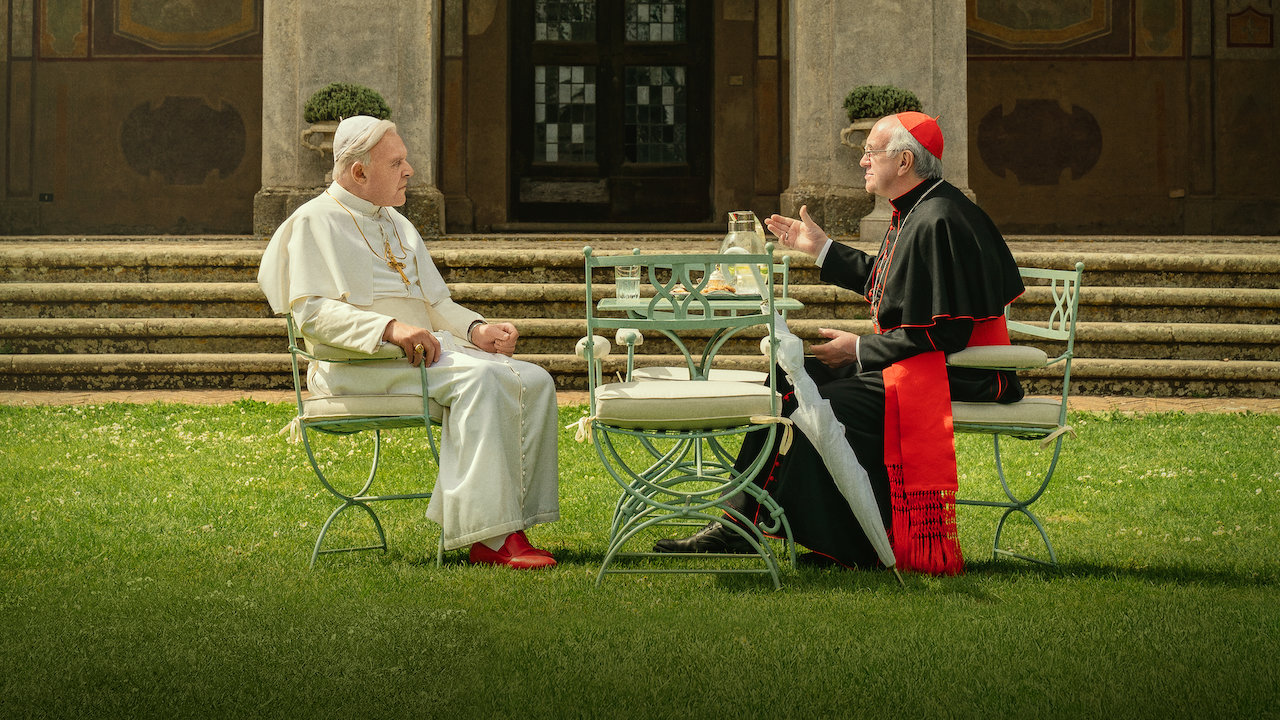Popes do not abdicate. In fact, before this century the only pontiff to have done so was Celestine V, an elderly hermit who had been in charge for just five months in 1294 before scurrying off back to the mountains. Poor Celestine was a bizarre choice for the job, and used to hide himself in a small cell during his short reign; afterwards his successor imprisoned the poor old man, because a second living pope could prove a threat, a focus for discontent among enemies of the supreme leader.
Fast forward seven hundred years and during a Monday morning conference at the Apostolic Palace Benedict XVI made his shock announcement, which an Italian journalist scooped because she spoke Latin.
Benedict’s resignation and the subsequent election of Cardinal Jorge Bergoglio as Pope Francis is the subject of Netflix’s latest TV movie The Two Popes.
Filmed in Argentina and Italy, funded by Americans, directed by Brazilian Fernando Meirelles and starring two fine Welsh actors, Jonathan Pryce and Anthony Hopkins, the film does well to capture the glamour and majesty of the Catholic Church.
The filmmakers actually built a larger replica of the Sistine Chapel, since filming there would have been a logistical nightmare even if the Church wanted it.
But essentially it is about two men, and two personality archetypes with different visions not just of the Catholic Church but of the world: the conscientious conservative and the open-minded liberal.
Because the film industry is dominated by liberals, therefore Francis, the liberal, is the star and the protagonist, while Benedict is someone coming to terms with his failings. He’s on the wrong side of history.
The director is a non-believing admirer of Pope Francis, and the film will appeal more to non-Catholics than the faithful (the Catholic Herald is not too keen).
I found it hugely enjoyable, even if it is quite simplistic in its representation of these two personality types: Ratzinger as the conservative, uptight and resistant to change, unforgiving of sexual freedom and lacking in personal warmth; Bergoglio as the liberal, generous, kind and forgiving, and prepared to change his opinion.
Benedict is so out of touch that he can’t even name any Beatles songs, and at one point confesses that he took to books because he was scared of really exploring life.
Crucially, of the big five personality traits, conservatives are much lower in openness, which is why Labour voters score higher in this trait.
Indeed, studies across many different countries have linked higher agreeableness, openness and neuroticism with Left-wing parties and higher conscientiousness with the Right.
High openness also explains why the arts, including the world of television and film, tend to be dominated by liberals; Francis is the ultimate liberal personality, which is why the secular Left-leaning media continues to love him, despite him still having views they find repugnant (what with him being Pope and everything).
Indeed, the films paints him as the reformer who will heal the wound of clerical child abuse, and Benedict as guilty of gross neglect, when most Church experts would say that Benedict XVI has a much stronger record on this subject. But then secular liberals like to see the world in clear black and white, so to accurately portray this would be complicate things — in this they are just like any other community of believers.











Join the discussion
Join like minded readers that support our journalism by becoming a paid subscriber
To join the discussion in the comments, become a paid subscriber.
Join like minded readers that support our journalism, read unlimited articles and enjoy other subscriber-only benefits.
Subscribe